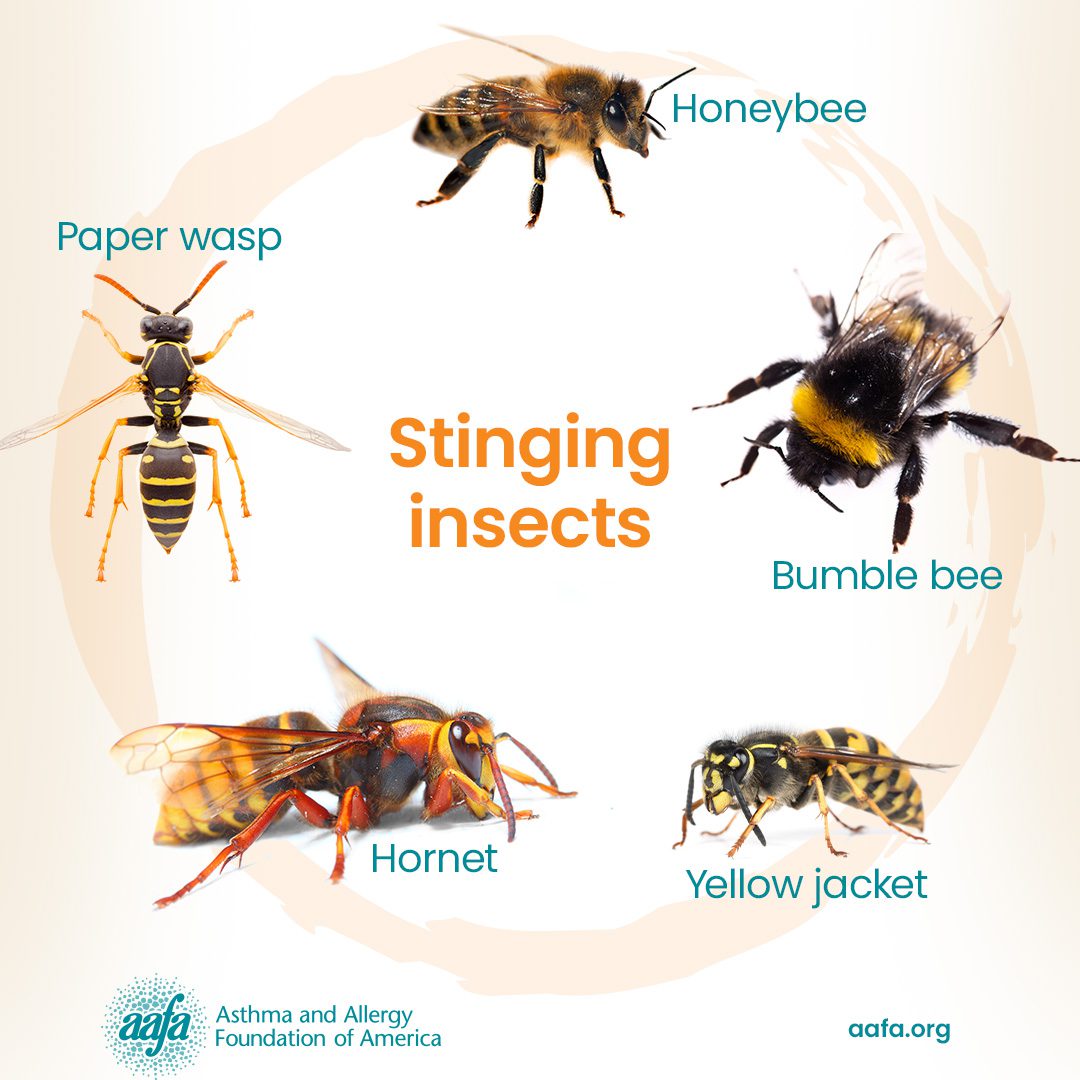Allergies
Stinging Insect Allergy: Bees, Wasps, Hornets, Yellow Jackets
Bees, wasps, hornets, and yellow jackets are common stinging insects that cause an allergic reaction. When these insects sting you, they inject a toxic substance called venom. Most people stung by these insects recover within hours or days. In some people, this venom can trigger a potentially life-threatening allergic reaction.
Bees usually only sting once. They have barbed stingers that remain attached to the skin after the sting. However, wasps, hornets, and yellow jackets do not have barbed stingers and can sting multiple times.
On this page:
What is a bee, wasp, hornet, or yellow jacket allergy?
What are the symptoms of stinging insect allergy?
What is the treatment for stinging insect allergy?
How do doctors diagnose stinging insect allergy?
How can I prevent allergic reactions to stinging insects?
How can I identify stinging insects?
What Is a Bee, Wasp, Hornet, or Yellow Jacket Allergy?
When bees, wasps, hornets, and yellow jackets sting, their stinger injects venom into the skin. Their venoms contain proteins that are allergens for many people. An allergen is a substance that causes an allergic immune reaction.1
Bees, wasps, hornets, and yellow jackets can sting anyone. Most stings occur by accident, due to an encounter with an insect or because someone disturbs a nest, which can result in the insects swarming and stinging multiple times. Outdoor workers and landscapers have a higher risk of being stung. Stinging insects are most active during late spring, summer, and early fall.1,2
People who have been stung in the past and had an allergic reaction have a high chance of a similar or worse reaction if stung again.2
What Are the Symptoms of a Stinging Insect Allergy?
Most people stung by a bee, wasp, hornet, or yellow jacket suffer pain, redness, itching, and minor swelling in the area around the bite or sting. This is a normal reaction. Most people get better within hours or days.3
However, after being stung, some people’s immune system can overreact, triggering an immune response that can cause a serious allergic reaction. A serious allergic reaction (anaphylaxis [anna-fih-LACK-sis]) produces signs and symptoms that require immediate medical attention. Without immediate treatment, anaphylaxis may cause death. Symptoms are usually systemic. This means they involve more than one part of the body, such as the skin or mouth, the lungs, the heart, and the gut. Some symptoms include:
- Skin rashes, itching, or hives
- Swelling of the lips, tongue, or throat
- Shortness of breath, trouble breathing, or wheezing (whistling sound during breathing)
- Dizziness and/or fainting
- Stomach pain, vomiting, bloating, or diarrhea
- Feeling like something awful is about to happen
Insect stings can cause other serious symptoms that are not an allergic response, including:
- Serum sickness which is an unusual reaction to a foreign substance in the body. It can cause symptoms that occur 7 to 10 days after the sting. Symptoms include fever, joint pain, other flu-like symptoms, and sometimes hives.
- A toxic reaction that happens when the body reacts to insect venom like it is a poison. A toxic reaction can cause symptoms similar to those of an allergic reaction. Other symptoms include nausea, fever, fainting, seizures, shock, and even death. This type of reaction is very uncommon and occurs when there have been multiple stings, typically hundreds.
What Is the Treatment for Stinging Insect Allergy?
If you get stung, don’t panic. Gently brush the insects from your skin, and walk away calmly from the area to avoid being stung again. If the insect left its stinger in your skin, remove it quickly by scraping it with your fingernail. The more time the sting stays embedded in the skin, the more venom it will inject. Do not squeeze the stinger as it may lead to more venom being injected into your skin. Gently wash the sting site with soap and water to prevent infections. Do not scratch or break blisters.3,4
Most insect stings need only supportive care with over-the-counter medicine. Applying a corticosteroid [kor-tick-OH-stair-ROID] (usually hydrocortisone) cream to the sting site is usually enough to relieve the localized symptoms such as itching and swelling. An oral antihistamine can also be helpful to relieve itching. An oral pain reliever (such as acetaminophen or ibuprofen) may also be helpful. The localized pain and swelling may also be improved by applying a cold compress and by raising the affected limb.3,4
Some reactions may become severe and cause systemic reactions such as anaphylaxis. If you experience symptoms like severe chest pain, nausea, sweating, shortness of breath, severe swelling, or slurred speech, you should immediately seek medical care.3,4
If you have a diagnosed allergy to stinging insects and you get stung, use epinephrine right away.
If you are experiencing a severe allergic reaction to a stinging insect for the first time and do not have epinephrine, call 911 and go to an emergency room for medical care.
Epinephrine [ep-uh-NEF-rin] can reverse severe systemic reactions and is the most important treatment available for anaphylaxis. If you have a severe allergy to insect bites or stings, you should carry an easy-to-use form of epinephrine. You should also consider wearing a medical identification bracelet or necklace containing information about your allergy.3,4
Your allergist may consider immunotherapy [eh-mu-no-THER-ah-pee] (allergy shots). Allergy shots contain small doses of your allergen. This approach allows your body to build a natural immunity to the allergen and may result in an effective and safe long-term treatment for the stinging insect allergy. Immunotherapy can help prevent or reduce the severity of allergic reactions.3,4
How Do Doctors Diagnose Stinging Insect Allergy?
To diagnose a stinging insect allergy, your doctor may give you a physical exam and discuss your symptoms and your history of allergic reactions to stings. The identification of the insect can also be helpful.2
If your doctor thinks you have a stinging insect allergy, they may suggest a skin or blood test.2
Skin prick test (SPT) – In prick/scratch testing, a small drop of the possible allergen is placed on your skin. Then the nurse or doctor will lightly prick or scratch the spot with a needle through the drop. If you are allergic to the substance, you will develop redness, swelling, and itching at the test site within 20 minutes. You may also see a wheal. A wheal is a raised, round area that looks like a hive. If the prick test for stinging insects is negative, they will proceed with intradermal testing.
Specific IgE blood test – Blood tests are helpful when people have a skin condition or are taking medicines that interfere with skin testing. They may also be used in children who may not tolerate skin testing. Your doctor will take a blood sample and send it to a laboratory. The lab adds the allergen to your blood sample. Then they measure the amount of antibodies your blood produces to attack the allergens. This test is called specific IgE (sIgE) blood testing (also referred to as RAST or ImmunoCAP testing).
How Can I Prevent Allergic Reactions to Stinging Insects?
If you have a known allergy to insect stings, then you should carry an easy-to-use form of epinephrine, so you can quickly treat a reaction wherever you are.2,3
Also, keep in mind that the best way to prevent allergic reactions to stinging insects is to avoid being stung by staying away from them. These insects are most likely to sting if their nests are disturbed. If you find a nest, move away quickly. If you have nests around your home, consider hiring a trained exterminator as the removal of these nests can be a dangerous task.2,3
Avoid high-risk exposures such as yard and garden work, trash containers, and outdoor areas where food and drink are exposed. Food and flavored drinks in cans, bottles, and straws can be an unsuspected source of a sting to the tongue or throat. The smell of food also attracts insects so be careful when cooking, eating or drinking sweet drinks outdoors. Keep the food covered and avoid open garbage cans.5
Avoidance of wearing brightly colored clothes is of uncertain benefit, and insect repellants have little or no effect.5
Wear closed-toe shoes outdoors, and avoid loose-fitting clothing. Be extra careful when gardening, and use gloves and socks to avoid being stung in the hands and feet.2,3
How Can I Identify Stinging Insects?

Honeybees have a round-shaped body, covered with fuzz, and with golden-yellow and dark brown stripes. Honeybees only sting when provoked. However, Africanized honeybees are known to be more aggressive and sting in swarms. Honeybees build their honeycombs in trees or sites that can provide some protection to the structure. 3,6
Bumble bees are bulkier and rounder than honeybees and have densely hairy bodies. Their bodies are usually dark with yellow bands but can also have orange or red bands. Bumble bees only sting when provoked. Unlike honeybees, bumble bees can sting multiple times. Bumble bees build their nests in holes in the ground, tunnels, or beneath clumps of rough grass.3,6
Paper wasps, yellow jackets, and hornets are related to each other and have some similar physical characteristics:
Paper wasps are slender, have a narrow waist, and black, brown, red and yellow markings. They have legs that dangle when they fly. Paper wasps can sting multiple times. They live in a circular comb of cells which opens downward, made of a grey paper-like material. Paper wasps’ nests can be commonly found in buildings’ roof spaces, behind shutters, or in bushes and woodpiles.3,7
Yellow jackets have black bodies with yellow spots and bands. Although they may resemble paper wasps, they do not have the narrow waist characteristic of paper wasps. Yellow jackets can sting multiple times. They can be found in different environments and climates. Yellow jackets’ nests are made of a grey paper-like material, wrapped in multiple layers, which makes the nest rounded. Although yellow jackets commonly build their nests underground, they can also be found in the walls of buildings, cracks, and in woodpiles.4,7
Hornets have black or brown bodies with white, orange, or yellow markings. Although they resemble yellow jackets, they are usually larger. Hornets can sting multiple times. Their nests are similar to yellow jackets’ nests. They look like a gray or brown football and are made of a paper-like material. Hornets’ nests can be commonly found in high branches of trees, eaves, bushes, or in tree hollows.4,7
Closed
References
- Arif, F. and Williams, M. (2023, June 20). Hymenoptera Stings. In StatPearls. StatPearls Publishing. Retrieved April 22, 2025, from: https://www.ncbi.nlm.nih.gov/books/NBK518972/
- American College of Allergy, Asthma and Immunology. (2023, June 28). Insect Sting Allergies. Retrieved April 22, 2025, from: https://acaai.org/allergies/allergic-conditions/insect-sting-allergies/
- American Academy of Allergy Asthma & Immunology. (2024, May 6). Stinging Insect Allergy. Retrieved April 22, 2025, from: https://www.aaaai.org/conditions-treatments/allergies/stinging-insect-allergy
- American Academy of Allergy Asthma & Immunology. (2025, January 10). Stinging Insect Allergy. Retrieved April 22, 2025, from: https://www.aaaai.org/tools-for-the-public/conditions-library/allergies/stinging-insect-allergy
- Golden, D. B. K., Demain, J., Freeman, T., Graft, D., Tankersley, M., Tracy, J., Blessing-Moore, J., Bernstein, D., Dinakar, C., Greenhawt, M., Khan, D., Lang, D., Nicklas, R., Oppenheimer, J., Portnoy, J., Randolph, C., Schuller, D., & Wallace, D. (2017). Stinging insect hypersensitivity. Annals of Allergy, Asthma & Immunology, 118(1), 28–54. https://doi.org/10.1016/j.anai.2016.10.031
- National Geographic. (n.d.). Bumblebees. Retrieved April 22, 2025, from: https://www.nationalgeographic.com/animals/invertebrates/facts/bumblebees
- Cornell University. College of Agriculture and Life Sciences. (n.d.). Identifying Bees and Wasps. Retrieved April 22, 2025, from: https://cals.cornell.edu/integrated-pest-management/outreach-education/whats-bugging-you/bees-and-wasps/identifying-bees-and-wasps
Med Communications, Inc. assisted with development and review of medical content. Medical review: April 2025 by Jeffrey G. Demain, MD










